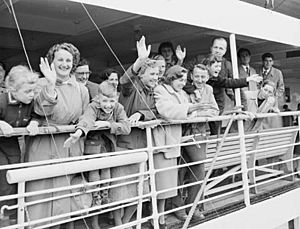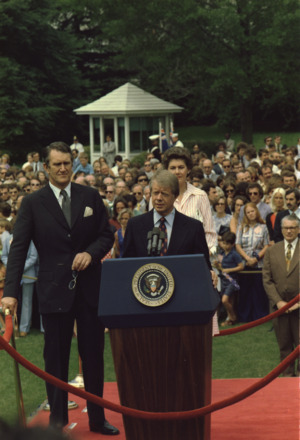History of Australia (1945–present) facts for kids
Australia's history since 1945 has been a time of big changes. The country saw long periods of good economic times. Many people from different countries came to live here. Australia also started to become less focused on Britain. Instead, it built stronger connections with the United States and countries in Asia.
Contents
- Australia in the Late 1940s
- Immigration and the Post-War Boom
- 1960s and 1970s: A New Australian Identity
- Australia and the Vietnam War
- Papua New Guinea and Nauru Gain Independence
- Whitlam, Fraser, and the Dismissal
- 1980s and 1990s: Economic Changes and New Parliament
- Indigenous Australia: Rights and Recognition
- Republicanism: A Debate About Australia's Head of State
- Military Engagements in the Late 20th Century
- Australia in the 21st Century
- See also
Australia in the Late 1940s
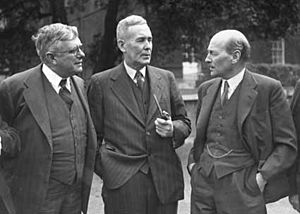
In 1944, the Liberal Party of Australia was formed. Robert Menzies became its first leader. This party would be very important in the years after World War II. Menzies wanted a new political group. He said it should work for fairness, safety, and national progress. He also wanted to help each person grow, but not through socialism.
In 1945, Prime Minister John Curtin sent Australian leaders to help create the United Nations. Australia played a key role in these early talks. It helped smaller nations have a bigger say. Australia also pushed for stronger rights for workers in the U.N. Charter. H V Evatt, an Australian leader, was even elected president of the UN General Assembly from 1948 to 1949.
After Prime Minister John Curtin passed away in July 1945, Ben Chifley became the new Labor leader. Chifley, who used to be a train driver, won the 1946 election. His government started big national projects. These included the Snowy Mountains Scheme and a program to help people immigrate. He also wanted the government to control more of the economy. This included making the government collect all income tax. He also tried to take over private banks.
Chifley believed Labor's goal was to make life better for everyone. He wanted to bring "greater happiness to the mass of the people." However, the economy became uncertain. After his attempt to nationalise the banks and a big coal strike, Chifley lost the 1949 election. Robert Menzies' new Liberal Party, working with the Country Party, won the election.
Immigration and the Post-War Boom

After World War II, Australia started a huge immigration program. Leaders believed Australia needed more people to protect itself. Prime Minister Ben Chifley said, "We must populate Australia as rapidly as we can." Hundreds of thousands of people from Europe, including many Jewish people, came to Australia. Over two million people moved to Australia from Europe in the 20 years after the war.
At first, Australia wanted most immigrants to be from Britain. This was to keep Australia's British culture. But to reach its goals, Australia also welcomed people from other European countries. From the late 1940s, many people came from Greece, Italy, Malta, Germany, Yugoslavia and the Netherlands. The government helped many of these new arrivals. They found jobs easily because the economy was growing. There were also big building projects.
Australia's economy was strong, unlike war-torn Europe. New immigrants found work in growing factories. They also worked on government projects like the Snowy Mountains Scheme. This huge project built dams and power stations in south-east Australia. It was built between 1949 and 1974. It is still the largest engineering project in Australia's history. About 100,000 people from over 30 countries worked on it. Many people see it as the start of multicultural Australia.
In 1949, the Labor government was defeated. A Liberal–National Party government, led by Sir Robert Menzies, took over. The Menzies government was in power for a long time. It won every federal election until 1972.
In the early 1950s, fears about communism grew, similar to the United States. Refugees from Soviet-controlled Eastern Europe came to Australia. In 1949, Mao Zedong won the Chinese civil war. In 1950, Communist North Korea invaded South Korea. The Menzies government sent Australian forces to help South Korea. This started Australia's involvement in the Korean War. The war ended in 1953. Australian soldiers fought in major battles like Kapyong and Maryang San. Over 1,500 Australians were injured, and 339 were killed.
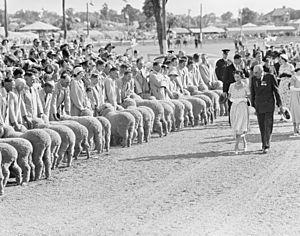
During the Korean War, the Menzies government tried to ban the Communist Party of Australia. Both attempts failed. Other events, like the defection of a Soviet official, made people more worried about threats. This helped Menzies' government politically. The Labor Party split in 1955 over concerns about communist influence in unions. This led to the creation of the Democratic Labor Party (DLP). The DLP was important until 1974. It often helped the Liberal and Country parties win elections.
Menzies led Australia during a time of strong economic growth. Big social changes also began. Rock and roll music and television arrived in the 1950s. In 1956, television in Australia started broadcasting. Melbourne hosted the Olympic Games. Also, Barry Humphries created his famous character Edna Everage. She was a funny look at Australian housewives of the 1950s.
In 1958, Australian country music singer Slim Dusty had Australia's first international music hit. It was his song "Pub With No Beer". Johnny O'Keefe's Wild One was the first local song to reach the national charts. In the 1950s, Australian cinema made few of its own movies. But British and Hollywood studios made successful films based on Australian books. These films featured Australian stars like Chips Rafferty and Peter Finch.
Menzies strongly supported Australia's ties to the monarchy and British Commonwealth. He also made an alliance with the United States. But he also started trading with Japan after the war. This led to Australia exporting more coal, iron ore, and minerals to Japan. Japan soon became Australia's biggest trading partner.
In the early 1950s, Menzies saw Australia as part of a "triple alliance" with the US and Britain. Australia supported Britain in diplomacy. It also looked for ways to involve the US in South East Asia. Besides the Korean War, Australia sent troops to the Malayan Emergency. It also hosted British nuclear tests after 1952. Australia was the only Commonwealth country to support Britain during the Suez Crisis.
Menzies welcomed Queen Elizabeth II on her first visit to Australia in 1954. Huge crowds met the Queen across Australia. As British influence in South East Asia lessened, the US alliance became more important for Australia. British investment in Australia remained strong until the late 1970s. But trade with Britain went down in the 1950s and 1960s. In the late 1950s, the Australian Army started using US military equipment. In 1962, the US built a naval station at North West Cape. This was the first of several built over the next ten years. Most importantly, in 1962, Australian Army advisors were sent to help train South Vietnamese forces. Britain was not involved in this growing conflict.
The ANZUS security treaty was signed in 1951. It was first about Australia's and New Zealand's fears of a rearmed Japan. But it gained new importance because of anti-communism. Its rules for the US, Australia, and New Zealand are not very clear. But it has sometimes had a big impact on Australia's foreign policy. The SEATO treaty, signed three years later, clearly showed Australia was a US ally in the Cold War. On November 26, 1967, Australia launched its first satellite, WRESAT, from Woomera. It was the seventh nation to put a satellite into orbit.
When Menzies retired in January 1966, Harold Holt became the new Liberal leader and Prime Minister. The Holt government increased Australia's involvement in the growing Vietnam War. It also oversaw the change to decimal currency. Holt also worked to strengthen ties with the United States. He hosted the first visit to Australia by an American president, Lyndon Johnson. Importantly, Holt's government introduced the Migration Act 1966. This law removed the last parts of the White Australia Policy. It allowed more non-European migrants, including refugees from the Vietnam War, to come to Australia. Holt also called the 1967 Referendum. This vote removed a unfair part of the Australian Constitution. It had stopped Aboriginal Australians from being counted in the census. Over 90% of Australians voted 'yes' in this referendum.
Holt won the 1967 election with a very large majority. But he drowned while swimming in December 1967. John Gorton became Prime Minister (1968–1971). The Gorton government started to reduce Australia's involvement in Vietnam. It also increased money for the arts. It made pay rates the same for men and women. And it continued to move Australian trade closer to Asia. The Liberals lost some voter support in the 1969 election. Internal party problems led to Gorton being replaced by William McMahon (1971–1972). Facing a stronger Australian Labor Party led by Gough Whitlam, the Liberals were nearing the end of their record 23 years in power.
1960s and 1970s: A New Australian Identity
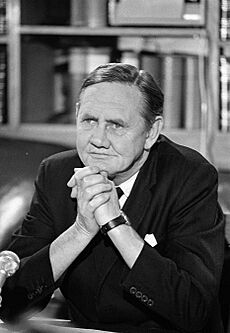
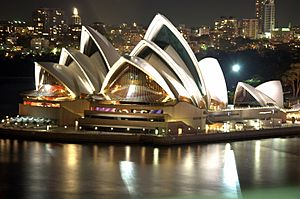
From the mid-1960s, Australians started to feel a new sense of national pride. In the early 1960s, the National Trust of Australia began to protect Australia's natural and historic places. Australian TV, while still showing many US and British shows, started making its own dramas and comedies. Shows like Homicide became very popular. Skippy the Bush Kangaroo became famous around the world. Liberal Prime Minister John Gorton said he was "Australian to the bootheels." His government created the Australian Council for the Arts, the Australian Film Development Corporation, and a film and TV training school.
The late 1960s and early 1970s saw a boom in Australian culture. Indigenous Australians gained more rights. Rules about immigration and censorship were changed. New theatre and opera companies started across the country. Australian rock music became very popular. The 1971 Springbok rugby tour helped raise awareness of unfair treatment of Aboriginal people. Australia became the first Western nation to stop sports ties with South Africa. Many Australians protested against the South African team because of their apartheid policy. The Australian media boss Kerry Packer changed the game of cricket in the 1970s. He created World Series Cricket, which led to many modern changes in the game.
The famous Sydney Opera House finally opened in 1973 after many delays. In the same year, Patrick White became the first Australian to win a Nobel Prize for Literature. By the 1970s, Australian History was taught in schools. From the early 1970s, Australian cinema started making new films. This was called the Australian New Wave. These films focused on unique Australian themes. Film funding began under the Gorton government. The South Australian Film Corporation helped make many great Australian films. These included Sunday Too Far Away (1974), Picnic at Hanging Rock (1975), Breaker Morant (1980), and Gallipoli (1981). The national film funding body, the Australian Film Commission, was set up in 1975.
Australia's censorship laws also changed a lot. This happened after Don Chipp became the new Liberal Minister for Customs in 1969. In 1968, a cartoon book about the Australian character Barry McKenzie was banned. But just a few years later, a film was made from the book. It even got government funding. Historians say that while many films and books in the 1970s criticised Australian life, they were also celebrated for being Australian.
Australia and the Vietnam War

In 1962, the Menzies government sent the first small group of Australian military trainers to South Vietnam. This started Australia's ten-year involvement in the Vietnam War. The leader of South Vietnam, Ngô Đình Diệm, had asked the US and its allies for help. The Australian government supported this. They saw it as part of a global effort to stop communism from spreading.
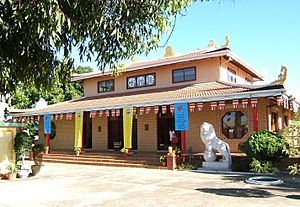
At first, Australia's involvement in Vietnam was popular. But later, it became very controversial, especially the use of conscription (forcing young men to join the army). There were huge, mostly peaceful, protests. The United States increased its involvement in 1965. The Holt government, which followed Menzies, also increased Australia's military commitment. Holt won a huge election victory in 1967. However, by 1969, anti-war protests were growing. More people believed the war could not be won. The Gorton government stopped replacing Australian soldiers from 1970. There were large protest marches in 1970 and 1971. Australia's troops continued to leave through 1971. The last battalion left Nui Dat in November. The election of the Whitlam government in 1972 officially ended Australia's small remaining role in the war in June 1973. The last platoon guarding the Australian Embassy in Saigon was withdrawn.
Australian forces were mainly based at Nui Dat, Phước Tuy Province. They fought in important battles like the Battle of Long Tan against the Viet Cong in 1966. They also helped defend against the 1968 Tet Offensive. Almost 60,000 Australians served in Vietnam. 521 died because of the war. As the war became unpopular, protestors became more visible. Soldiers often faced a hostile welcome when they returned home later in the conflict.
In early 1975, the communists launched a major attack. This led to the fall of Saigon on April 30. The Royal Australian Airforce helped with final humanitarian evacuations. After the communist victory, Australia helped resettle Vietnamese refugees. Thousands came to Australia throughout the 1970s and 1980s.
Papua New Guinea and Nauru Gain Independence
Australia had managed Papua New Guinea and Nauru for most of the 20th century. British New Guinea (Papua) became part of Australia in 1906. German New Guinea was captured by Australia during World War I. It became a League of Nations mandate after the war. After the tough New Guinea campaign in World War II, the Territory of Papua and New Guinea was formed in 1949. This joined the two Australian-managed territories. Under Liberal Minister Andrew Peacock, Papua and New Guinea became self-governing in 1972. On September 15, 1975, during the Whitlam government in Australia, it became the independent nation of Papua New Guinea.
Australia had taken the island of Nauru from Germany in 1914. After Japanese occupation during World War II, it became a UN Trust Territory under Australia. Nauru gained independence in 1968. In 1989, Nauru sued Australia for damage caused by mining. Australia settled the case out of court. It agreed to pay Nauru A$107 million and an annual payment for environmental repairs.
Whitlam, Fraser, and the Dismissal

In December 1972, the Australian Labor Party won power after 23 years in opposition. Gough Whitlam became Prime Minister. His government quickly brought in many social changes. Whitlam said his goals were to promote equality, involve Australians in decisions, and help people develop their talents.
Whitlam's actions were fast and dramatic. Within weeks, the last military advisors in Vietnam were called home. National service (conscription) ended. Australia recognised the People's Republic of China. University fees were removed, and a national health care system was set up. Big changes were made to school funding. Divorce and family laws were made more modern.
Whitlam's bold style eventually upset many voters. Some state governments were openly against his government. Since Labor did not control the Senate, much of its new laws were rejected. The Queensland Country Party government, led by Joh Bjelke-Petersen, had very bad relations with the federal government. Even after being re-elected in 1974, the Senate remained a problem for Whitlam's plans.
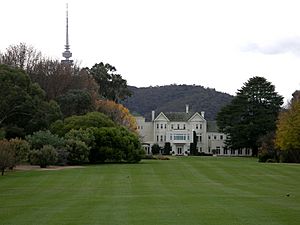
In 1974, Whitlam chose John Kerr to be the Governor-General. Kerr was a former Labor Party member. In 1974–75, the government considered borrowing a lot of money from overseas. Minister Rex Connor had secret talks with a loan broker. Treasurer Jim Cairns misled parliament about the issue. The opposition, led by Malcolm Fraser, argued the government was not managing well. They blocked the government's money bills in the Senate. They demanded a new election. Whitlam refused.
The problem ended when the Whitlam government was dismissed by the Governor-General, John Kerr, on November 11, 1975. Fraser was made caretaker Prime Minister until an election. The "reserve powers" of the Governor-General allowed an elected government to be dismissed without warning.
At the election held in late 1975, Malcolm Fraser and his Coalition won by a landslide victory.
The Fraser government won two more elections. Fraser kept some of Whitlam's social reforms. But he also tried to control government spending. His government included the first Aboriginal federal politician, Neville Bonner. In 1976, a law was passed that gave Aboriginal people in the Northern Territory legal ownership of some traditional lands. Fraser created the multicultural broadcaster SBS. He welcomed Vietnamese refugees. He opposed white minority rule in Apartheid South Africa and Rhodesia. He also opposed Soviet expansion.
However, Fraser did not make big economic reforms. By 1983, the Australian economy was in a downturn. There was also a severe drought. Fraser supported "states' rights." His government refused to stop the building of the Franklin Dam in Tasmania in 1982. A Liberal minister, Don Chipp, left the party to form the Australian Democrats in 1977. The Franklin Dam issue helped create a strong Environmental movement in Australia. This led to the Australian Greens political party.
1980s and 1990s: Economic Changes and New Parliament
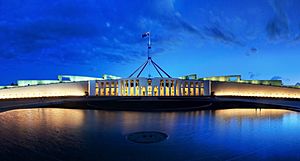
Bob Hawke, a less controversial Labor leader than Whitlam, defeated Fraser in the 1983 Election. The new government stopped the Franklin Dam project. The 1980s saw worries about Australia's economic future. There were large trade deficits and high unemployment at times. Hawke, with his Treasurer Paul Keating, made changes to the economy and industrial relations. These changes aimed to make Australia more efficient and competitive.
After the Whitlam government's health plan failed, Hawke brought back a new national health insurance system called Medicare. Hawke and Keating stopped Labor's traditional support for tariffs. Tariffs are taxes on imported goods that protect local industries. They also removed controls on Australia's financial system and let the Australian dollar's value float freely. They made a deal with trade unions to keep wage demands moderate in exchange for tax cuts. Many of these reforms, continued by later governments, helped the economy grow.
Australia celebrated its Bicentenary in 1988. A new Parliament House was opened in Canberra. The next year, the Australian Capital Territory became self-governing. Jervis Bay became a separate territory.
Hawke supported the US alliance. He sent Australian naval forces to the Gulf War in 1991. This was after Iraq invaded Kuwait. After winning four elections, but with a struggling Australian economy and rising unemployment, Hawke was replaced. The rivalry between Hawke and Keating led the Labor Party to choose Paul Keating as Prime Minister in 1991.
Unemployment reached 11.4% in 1992. This was the highest since the Great Depression. The Liberal-National Opposition had a big economic reform plan for the 1993 Election. This included a new goods and services tax. Keating campaigned strongly against this tax and won the election. During his time, Keating focused on Australia's links to Asia. He worked closely with the Indonesian President, Suharto. He also pushed for APEC to be a major forum for economic cooperation.
Keating was active in Indigenous affairs. The High Court of Australia's important Mabo decision in 1992 meant new laws were needed to recognise Indigenous land rights. This led to the Native Title Act 1993. In 1993, Keating set up a committee to look at Australia becoming a republic. With high foreign debt, interest rates, and unemployment, Keating lost the 1996 Election to the Liberals' John Howard.
Full Independence from the United Kingdom
The Australia Act 1986 cut almost all legal ties between Australia and the UK. This law removed the British Parliament's right to make laws for Australia. It also ended any British role in the government of Australian States. It stopped appeals from Australian courts to the British Privy Council in London. Most importantly, the Act gave Australia full control of all its own constitutional documents.
Indigenous Australia: Rights and Recognition
Campaigns for Indigenous rights in Australia have a long history. In 1938, Aboriginal activists organised a "Day of Mourning." This marked 150 years since the British arrived. They demanded full citizenship rights for all Aboriginal people. In the 1940s, life for Aboriginal people was often very hard. A permit system limited their movement and work. In the 1950s, the government aimed for "assimilation." This meant Aboriginal people would gain full rights but were expected to adopt the way of life of other Australians. This often meant losing their cultural identity.
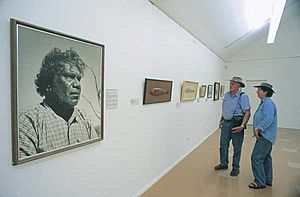
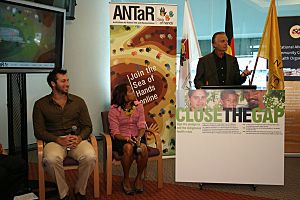
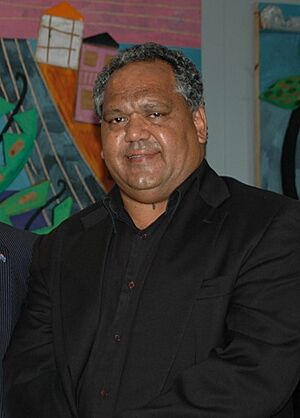
From the 1950s, Australians started to change their views on race. An Aboriginal rights movement began, supported by many white Australians. A campaign against the White Australia policy also started. The 1967 referendum was held. It overwhelmingly approved changing the Constitution. This removed unfair references and gave the national parliament power to make laws for Indigenous Australians. This referendum did not give Aboriginal people citizenship or the right to vote; they already had these. But it ended the system of Indigenous Australian reserves in each state. This allowed Indigenous people to move more freely and use their citizenship rights. From the late 1960s, a movement for Indigenous land rights also grew.
Many groups and individuals worked for equality from the 1960s. In the mid-1960s, Charles Perkins helped organise "freedom rides." These trips exposed discrimination in parts of Australia. In 1966, the Gurindji people of Wave Hill station went on strike. Led by Vincent Lingiari, they fought for equal pay and land rights.
Indigenous Australians began to serve in Australian parliaments in the 1970s. In 1971, Neville Bonner became the first Aboriginal person in Federal Parliament. He was a Liberal Party Senator. He served until 1983. Hyacinth Tungutalum and Eric Deeral were the first Indigenous people elected to territory and state parliaments in 1974. In 1976, Sir Douglas Nicholls became Governor of South Australia. He was the first Aboriginal person to hold such a high office. Ken Wyatt became the first Indigenous person elected to the House of Representatives in 2010.
In 1984, a group of Pintupi people living a traditional hunter-gatherer life were found in the Gibson Desert. They are believed to be the last uncontacted tribe in Australia. In 1985, the Hawke government gave ownership of Uluru (Ayers Rock) back to the local Pitjantjatjara Aboriginal people.
In 1992, the High Court of Australia ruled in the Mabo Case. It said the old idea of terra nullius (land belonging to no one) was wrong. That same year, Prime Minister Paul Keating said in his Redfern Park Speech that European settlers were responsible for the problems Aboriginal communities faced. He said, "We committed the murders. We took the children from their mothers." In 1999, Parliament passed a Motion of Reconciliation. It called the mistreatment of Indigenous Australians the "most blemished chapter in our national history."
Many Indigenous Australians have become famous in sport and the arts. Several styles of Aboriginal art have developed. These include the watercolour paintings of Albert Namatjira and the acrylic "dot art" of Papunya Tula. The Western Desert Art Movement became world-famous. Oodgeroo Noonuccal (1920–1995) was a famous Aboriginal poet and activist. She published the first Aboriginal book of poems. Sally Morgan's book My Place helped bring Indigenous stories to a wider audience.
Jedda (1955) was the first Australian film to star Aboriginal actors in lead roles. It was also the first to be shown at the Cannes Film Festival. The Chant of Jimmie Blacksmith (1976) was an award-winning drama about an Aboriginal Bushranger. More films about Indigenous Australians were made in the 1990s and early 2000s. In 2006, Ten Canoes was the first major film shot in an Indigenous language. It won awards at Cannes.
In sport, Evonne Goolagong Cawley became the world's number-one tennis player in 1971. She won 14 Grand Slam titles. In 1973, Arthur Beetson was the first Indigenous Australian to captain his country in any sport (rugby league). In 1982, Mark Ella became captain of the Australian national rugby union team. Olympic gold medalist Cathy Freeman lit the Olympic flame at the 2000 Summer Olympics opening ceremony in Sydney.
In the early 21st century, many Indigenous Australians still faced lower standards of health and education. In 2007, the Close the Gap campaign was launched. Its goal was to achieve health equality for Indigenous people within 25 years. In 2007, Prime Minister John Howard launched the Northern Territory National Emergency Response. This was in response to a report about child safety. The government held back some welfare payments for essential goods. It sent more police and medical staff. It also stopped the permit system for entering Indigenous communities.
For much of the 20th century, Australian governments removed many Aboriginal children from their families. This practice caused great harm. These children are known as the stolen generation. After a 1997 government report, all state governments formally apologised for these past actions. The Howard government at first refused to apologise on behalf of the federal government. But the new government under Kevin Rudd made a formal, bipartisan apology on February 13, 2008.
Republicanism: A Debate About Australia's Head of State
In the early 21st century, Australia is still a constitutional monarchy. This means the Queen or King of the UK is also Australia's head of state. A Governor-General, chosen by the Australian Government, performs the monarch's duties. The idea of Australia becoming a republic (having an Australian head of state) was popular in the 1890s. But it faded during World War I. Support for the Monarchy in Australia was highest during the Menzies years. This was after the very successful 1954 tour by Queen Elizabeth II.
The issue of a republic came up again in the 1970s. In the 1990s, Prime Minister Paul Keating brought it to the forefront. He promised in 1993 to make Australia a republic by 2001.
The Howard government called a Constitutional Convention in 1998. This meeting looked at the issue. It included people who supported a republic, those who supported the monarchy, and neutral parties. The Convention suggested a republican model. A referendum was then held on November 6, 1999. Voters had to approve the change. The referendum failed. Only 45.13% of voters supported Australia becoming a republic. 54.87% were against it.
The Australian Labor Party supported the republic. The Liberals allowed their members to campaign for either side. Many former Labor Prime Ministers supported the republic. So did former Liberal Prime Minister Malcolm Fraser. Notable monarchists included Prime Minister John Howard and Justice Michael Kirby.
Justice Michael Kirby, a monarchist, listed ten reasons why the referendum failed. These included a lack of agreement between parties, too much haste, and a feeling that the republic was only supported by big city elites. There were also concerns about the specific model proposed. Many people wanted a directly elected president, but the proposal was for an indirectly elected one.
Some republicans blamed Prime Minister John Howard for the failure. But other factors were important. There was a split between republicans who wanted an indirectly elected president and those who wanted a directly elected one. Public opinion suggested a republic would only be accepted if the president was directly elected.
The Gillard government (Labor) decided not to revisit the issue of a republic during the reign of Queen Elizabeth II. The Opposition Liberal-National Coalition, led by Tony Abbott, supported the monarchy. In 2011, public support for a republic fell to its lowest level since 1994.
In September 2022, Queen Elizabeth II died. Her eldest son, King Charles III, became the new King of Australia.
Military Engagements in the Late 20th Century
After the Vietnam War, Australian military forces mostly stayed home in the 1970s and 1980s. They did serve in United Nations peacekeeping missions. RAAF helicopters worked in the Sinai. Australian forces helped in a British Commonwealth operation when Zimbabwe became independent. They also helped in Namibia.
Bob Hawke was Prime Minister when the Fall of the Berlin Wall happened. This ended the Cold War and started a new era. Royal Australian Navy warships were sent to the Gulf War by the Hawke government in 1991. They stayed in the region to enforce UN rules against Iraq.
Peacekeeping Missions
Australian forces were very active in UN peacekeeping in the 1990s. In 1993, Foreign Minister Gareth Evans worked to find a solution to problems in Cambodia. This was after the terrible 1970s Pol Pot regime. Australia provided the force commander and communications for the UN operation. In the Somalia intervention, an Australian group helped deliver aid. In 1994, Australia sent medical staff to the UN force in Rwanda after the Rwandan genocide. A UN peacekeeping mission in Bougainville began in 1997. This helped resolve a long conflict there.
Australia has also been involved in other peacekeeping operations. These include Operation Bel Isi (1998–2003) in Bougainville. Also, Operation Helpem Fren and the Australian-led Regional Assistance Mission to Solomon Islands (RAMSI) in the early 2000s. And the 2006 East Timorese crisis.
East Timor Intervention
Australia led an important international military mission to East Timor in 1999. Indonesia invaded East Timor in 1975 and took over the former Portuguese colony. Earlier Australian governments had accepted Indonesia's control. But the fall of Indonesian President Suharto and a change in Australian policy by the Howard government in 1998 led to a new idea. A vote on independence was proposed. New Indonesian President B. J. Habibie was open to changing East Timor's status.
In late 1998, Australian Prime Minister John Howard suggested that East Timor should vote on independence within ten years. This upset President Habibie. He saw it as calling Indonesia a "colonial power." In response, he announced a quick referendum. A UN sponsored vote in August 1999 showed huge support for independence. After the results, violent clashes started. These were caused by groups against independence. This led to a humanitarian crisis.
John Howard talked to UN Secretary General Kofi Annan and US President Bill Clinton. He asked them to support an Australian-led peacekeeping force. Australia sent 5,500 people and the force commander, Major General Peter Cosgrove. The UN-backed International Force East Timor started deploying on September 20, 1999. It successfully restored order. The operation was tense. Australia moved combat aircraft north. An Indonesian submarine was detected near Dili Harbour as INTERFET forces arrived. The intervention was successful. But Australian-Indonesian relations took several years to improve.
Australia in the 21st Century
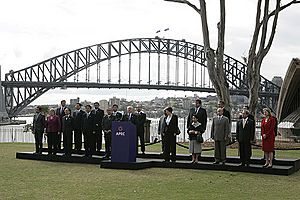

John Howard was Prime Minister from 1996 to 2007. He was the second-longest serving Prime Minister after Robert Menzies. One of his first programs was a national gun control scheme. The government aimed to reduce Australia's government debt. It also made changes to industrial relations. After the 1996 election, Howard and Treasurer Peter Costello proposed a goods and services tax (GST). They successfully introduced it after the 1998 election. In 1999, Australia led a United Nations force into East Timor. This helped East Timor gain democracy and independence.
The government also sped up privatisation. This started with the government-owned telecommunications company, Telstra. Howard's government continued foreign policies based on relations with four key countries: the United States, Japan, China, and Indonesia. The Howard government strongly supported US involvement in the Asia-Pacific region.
Australia hosted the 2000 Summer Olympics in Sydney. They were praised internationally. The Opening Ceremony showed many Australian symbols and history. The flame ceremony honoured women athletes. Aboriginal runner Cathy Freeman lit the Olympic flame. The President of the International Olympic Committee said they were "the best Olympic Games ever."
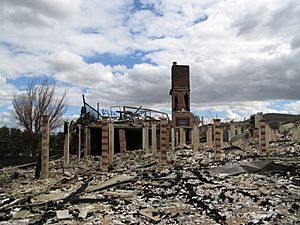

Sydney hosted other important world events. These included the 2003 Rugby World Cup, the APEC Leaders conference of 2007, and Catholic World Youth Day 2008. Melbourne hosted the 2006 Commonwealth Games.
In 2001, Australia celebrated its Centenary of Federation. Events were held, and the Centenary Medal was created. This medal honoured people who contributed to Australian society or government.
The Howard government increased immigration. But it also brought in strict immigration laws to stop unauthorised boat arrivals. Howard strongly supported traditional links to the Commonwealth and the United States alliance. Trade with Asia, especially China, continued to grow greatly. Australia had a long period of economic success. Howard's time in office included the 2001 11 September attacks. After this, the government sent troops to the Afghanistan War and the Iraq War.
Southern Australia suffered a very severe drought for much of the early 21st century. By late 2006, water levels were at record lows. Strict limits on city water use were put in place in most capital cities. Irrigation in the Murray–Darling basin was greatly reduced. Water supply became a big political topic. However, the drought's economic impact was mostly felt in Australia's farming areas.
Howard lost his large majority in the 1998 Federal election. He improved it in the 2001 Federal election and the 2004 election. But his government lost the 2007 Federal election to the Labor Party. Kevin Rudd led Labor to victory with a call for "new leadership."
Kevin Rudd was Prime Minister until June 2010. He was replaced by his deputy, Julia Gillard, after an internal Labor Party vote. Rudd used his time to formally agree to the Kyoto Protocol. He also led a historic parliamentary apology to the Stolen Generation. This refers to Indigenous Australians removed from their families. Rudd, who spoke Mandarin Chinese, also pursued an active foreign policy. He tried to introduce a price on carbon to fight global warming. His prime ministership happened during the start of the Financial crisis of 2007–2010. His government responded with a large economic stimulus package. This later became controversial.
The Black Saturday bushfires hit Victoria in February 2009. These fires happened during extreme weather conditions. They caused Australia's highest loss of life from a bushfire, with 173 people dying.
Amidst controversy over stimulus spending and policies on tax, immigration, and climate change, Labor replaced Rudd with Julia Gillard. She became Australia's first woman Prime Minister. She narrowly kept power after the 2010 Federal election. She gained support from independent members, leading to Australia's first hung parliament since 1940.
The drought ended with severe flooding in the summer of 2010–2011. This was due to the La Niña weather effect. Queensland especially suffered dramatic flooding. It swept through parts of Brisbane and caused deaths and financial loss. Soon after, tropical cyclone Yasi hit the coast.
After two and a half decades of economic reform and booming trade with Asia, Australia avoided a recession. This was unlike most other Western nations after the 2008 financial collapse. After the 2010 election, the Gillard government formed an alliance with the Australian Greens. It faced problems because it broke an election promise not to introduce a carbon tax. There was also leadership rivalry. The government struggled to pass some controversial laws. However, the alliance continued. In October 2011, the government passed its Clean Energy Bill 2011. This aimed to change the Australian economy to reduce greenhouse gas emissions by increasing costs for carbon emissions. A carbon tax was introduced on July 1, 2012.
Kevin Rudd was reinstated as Prime Minister on June 27, 2013. After the 2013 Australian General Election, Rudd lost to Tony Abbott, the Liberal Leader. On December 15, 2013, most Australian military forces left Afghanistan. The remaining troops trained locals in Kabul. The Clean Energy Bill 2011 was removed by the Abbott government on July 17, 2014. Malcolm Turnbull became Prime Minister from 2015 to 2018. He was replaced by Scott Morrison.
The end of 2019 and early 2020 saw intense bushfires on the east coast. These were known as the "Black Summer." The fires directly killed 34 people. About 9,352 buildings were destroyed. These fires were likely Australia's costliest natural disaster, at about A$100 billion. The smoke covered areas far from the fires for months. It even reached South America. Air quality dropped to dangerous levels in all southern and eastern states. Researchers estimated that 80% of Australians were affected by bushfire smoke. 445 people may have died indirectly from smoke inhalation.
Late January 2020 also saw the first local infections of a new virus, severe acute respiratory syndrome coronavirus 2. This led to the world-wide COVID-19 pandemic. By the end of 2020, 909 people had died in Australia from COVID-19. Globally, over 2.29 million deaths had occurred by February 5, 2021.
In the early morning of September 9, 2022, Queen Elizabeth II died. Her eldest son, King Charles III, became the new King of Australia.
See also
- History of broadcasting in Australia


